Wikipedia:WikiProject Astronomy/Eclipses task force/SESetLists
This eclipse is a member of a semester series. An eclipse in a semester series of solar eclipses repeats approximately every 177 days and 4 hours (a semester) at alternating nodes of the Moon's orbit.[1]
The solar eclipses on January 22, 1898 (total) and July 18, 1898 (annular) occur in the previous lunar year eclipse set, and the partial solar eclipse on April 8, 1902 occurs in the next lunar year eclipse set.
| Solar eclipse series sets from 1898 to 1902 | ||||||
|---|---|---|---|---|---|---|
| Ascending node | Descending node | |||||
| Saros | Map | Gamma | Saros | Map | Gamma | |
| 111 | December 13, 1898 Partial |
−1.5252 | 116 | June 8, 1899 Partial |
1.2089 | |
| 121 | December 3, 1899 Annular |
−0.9061 | 126 Totality in Wadesboro, North Carolina |
May 28, 1900 Total |
0.3943 | |
| 131 | November 22, 1900 Annular |
−0.2245 | 136 | May 18, 1901 Total |
−0.3626 | |
| 141 | November 11, 1901 Annular |
0.4758 | 146 | May 7, 1902 Partial |
−1.0831 | |
| 151 | October 31, 1902 Partial |
1.1556 | ||||
This eclipse is a member of a semester series. An eclipse in a semester series of solar eclipses repeats approximately every 177 days and 4 hours (a semester) at alternating nodes of the Moon's orbit.[2]
The partial solar eclipses on May 7, 1902 and October 31, 1902 occur in the previous lunar year eclipse set, and the partial solar eclipse on July 21, 1906 occurs in the next lunar year eclipse set.
| Solar eclipse series sets from 1902 to 1906 | ||||||
|---|---|---|---|---|---|---|
| Descending node | Ascending node | |||||
| Saros | Map | Gamma | Saros | Map | Gamma | |
| 108 | April 8, 1902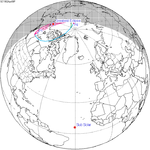 Partial |
1.5024 | 113 | October 1, 1902 | ||
| 118 | March 29, 1903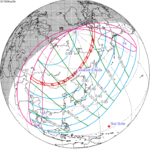 Annular |
0.8413 | 123 | September 21, 1903 Total |
−0.8967 | |
| 128 | March 17, 1904 Annular |
0.1299 | 133 | September 9, 1904 Total |
−0.1625 | |
| 138 | March 6, 1905 Annular |
−0.5768 | 143
|
August 30, 1905 Total |
0.5708 | |
| 148 | February 23, 1906 Partial |
−1.2479 | 153 | August 20, 1906 Partial |
1.3731 | |
This eclipse is a member of a semester series. An eclipse in a semester series of solar eclipses repeats approximately every 177 days and 4 hours (a semester) at alternating nodes of the Moon's orbit.[3]
The partial solar eclipses on February 23, 1906 and August 20, 1906 occur in the previous lunar year eclipse set.
| Solar eclipse series sets from 1906 to 1909 | ||||||
|---|---|---|---|---|---|---|
| Ascending node | Descending node | |||||
| Saros | Map | Gamma | Saros | Map | Gamma | |
| 115 | July 21, 1906 Partial |
−1.3637 | 120 | January 14, 1907 Total |
0.8628 | |
| 125 | July 10, 1907 Annular |
−0.6313 | 130 | January 3, 1908 Total |
0.1934 | |
| 135 | June 28, 1908 Annular |
0.1389 | 140 | December 23, 1908 Hybrid |
−0.4985 | |
| 145 | June 17, 1909 Hybrid |
0.8957 | 150 | December 12, 1909 Partial |
−1.2456 | |
This eclipse is a member of a semester series. An eclipse in a semester series of solar eclipses repeats approximately every 177 days and 4 hours (a semester) at alternating nodes of the Moon's orbit.[4]
The partial solar eclipse on August 31, 1913 occurs in the next lunar year eclipse set.
| Solar eclipse series sets from 1910 to 1913 | ||||||
|---|---|---|---|---|---|---|
| Ascending node | Descending node | |||||
| Saros | Map | Gamma | Saros | Map | Gamma | |
| 117 | May 9, 1910 Total |
−0.9437 | 122 | November 2, 1910 Partial |
1.0603 | |
| 127 | April 28, 1911 Total |
−0.2294 | 132 | October 22, 1911 Annular |
0.3224 | |
| 137 | April 17, 1912 Hybrid |
0.528 | 142 | October 10, 1912 Total |
−0.4149 | |
| 147 | April 6, 1913 Partial |
1.3147 | 152 | September 30, 1913 Partial |
−1.1005 | |
This eclipse is a member of a semester series. An eclipse in a semester series of solar eclipses repeats approximately every 177 days and 4 hours (a semester) at alternating nodes of the Moon's orbit.[5]
The partial solar eclipses on April 6, 1913 and September 30, 1913 occur in the previous lunar year eclipse set, and the solar eclipses on December 24, 1916 (partial), June 19, 1917 (partial), and December 14, 1917 (annular) occur in the next lunar year eclipse set.
| Solar eclipse series sets from 1913 to 1917 | ||||||
|---|---|---|---|---|---|---|
| Descending node | Ascending node | |||||
| Saros | Map | Gamma | Saros | Map | Gamma | |
| 114 | August 31, 1913 Partial |
1.4512 | 119 | February 25, 1914 Annular |
−0.9416 | |
| 124 | August 21, 1914 Total |
0.7655 | 129 | February 14, 1915 Annular |
−0.2024 | |
| 134 | August 10, 1915 Annular |
0.0124 | 139
|
February 3, 1916 Total |
0.4987 | |
| 144 | July 30, 1916 Annular |
−0.7709 | 149 | January 23, 1917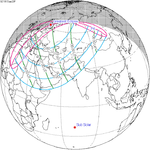 Partial |
1.1508 | |
| 154 | July 19, 1917 Partial |
−1.5101 | ||||
This eclipse is a member of a semester series. An eclipse in a semester series of solar eclipses repeats approximately every 177 days and 4 hours (a semester) at alternating nodes of the Moon's orbit.[6]
The solar eclipses on February 3, 1916 (total), July 30, 1916 (annular), January 23, 1917 (partial), and July 19, 1917 (partial) occur in the previous lunar year eclipse set.
| Solar eclipse series sets from 1916 to 1920 | ||||||
|---|---|---|---|---|---|---|
| Ascending node | Descending node | |||||
| Saros | Map | Gamma | Saros | Map | Gamma | |
| 111 | December 24, 1916 Partial |
−1.5321 | 116 | June 19, 1917 Partial |
1.2857 | |
| 121 | December 14, 1917 Annular |
−0.9157 | 126 | June 8, 1918 Total |
0.4658 | |
| 131 | December 3, 1918 Annular |
−0.2387 | 136 Totality in Príncipe |
May 29, 1919 Total |
−0.2955 | |
| 141 | November 22, 1919 Annular |
0.4549 | 146 | May 18, 1920 Partial |
−1.0239 | |
| 151 | November 10, 1920 Partial |
1.1287 | ||||
This eclipse is a member of a semester series. An eclipse in a semester series of solar eclipses repeats approximately every 177 days and 4 hours (a semester) at alternating nodes of the Moon's orbit.[7]
The partial solar eclipse on July 31, 1924 occurs in the next lunar year eclipse set.
| Solar eclipse series sets from 1921 to 1924 | ||||||
|---|---|---|---|---|---|---|
| Descending node | Ascending node | |||||
| Saros | Map | Gamma | Saros | Map | Gamma | |
| 118 | April 8, 1921 Annular |
0.8869 | 123 | October 1, 1921 Total |
−0.9383 | |
| 128 | March 28, 1922 Annular |
0.1711 | 133 | September 21, 1922 Total |
−0.213 | |
| 138 | March 17, 1923 Annular |
−0.5438 | 143 | September 10, 1923 Total |
0.5149 | |
| 148 | March 5, 1924 Partial |
−1.2232 | 153 | August 30, 1924 Partial |
1.3123 | |
This eclipse is a member of a semester series. An eclipse in a semester series of solar eclipses repeats approximately every 177 days and 4 hours (a semester) at alternating nodes of the Moon's orbit.[8]
The partial solar eclipses on March 5, 1924 and August 30, 1924 occur in the previous lunar year eclipse set, and the solar eclipses on May 19, 1928 and November 12, 1928 occur in the next lunar year eclipse set.
| Solar eclipse series sets from 1924 to 1928 | ||||||
|---|---|---|---|---|---|---|
| Ascending node | Descending node | |||||
| Saros | Map | Gamma | Saros | Map | Gamma | |
| 115 | July 31, 1924 Partial |
−1.4459 | 120 | January 24, 1925 Total |
0.8661 | |
| 125 | July 20, 1925 Annular |
−0.7193 | 130 Totality in Sumatra, Indonesia |
January 14, 1926 Total |
0.1973 | |
| 135 | July 9, 1926 Annular |
0.0538 | 140 | January 3, 1927 Annular |
−0.4956 | |
| 145 | June 29, 1927 Total |
0.8163 | 150 | December 24, 1927 Partial |
−1.2416 | |
| 155 | June 17, 1928 Partial |
1.5107 | ||||
This eclipse is a member of a semester series. An eclipse in a semester series of solar eclipses repeats approximately every 177 days and 4 hours (a semester) at alternating nodes of the Moon's orbit.[9]
The partial solar eclipse on June 17, 1928 occurs in the previous lunar year eclipse set, and the partial solar eclipse on September 12, 1931 occurs in the next lunar year eclipse set.
| Solar eclipse series sets from 1928 to 1931 | ||||||
|---|---|---|---|---|---|---|
| Ascending node | Descending node | |||||
| Saros | Map | Gamma | Saros | Map | Gamma | |
| 117 | May 19, 1928 Total (non-central) |
1.0048 | 122 | November 12, 1928 Partial |
1.0861 | |
| 127 | May 9, 1929 Total |
−0.2887 | 132 | November 1, 1929 Annular |
0.3514 | |
| 137 | April 28, 1930 Hybrid |
0.473 | 142 | October 21, 1930 Total |
−0.3804 | |
| 147 | April 18, 1931 Partial |
1.2643 | 152 | October 11, 1931 Partial |
−1.0607 | |
This eclipse is a member of a semester series. An eclipse in a semester series of solar eclipses repeats approximately every 177 days and 4 hours (a semester) at alternating nodes of the Moon's orbit.[10]
The partial solar eclipses on April 18, 1931 and October 11, 1931 occur in the previous lunar year eclipse set, and the solar eclipses on January 5, 1935 (partial), June 30, 1935 (partial), and December 25, 1935 (annular) occur in the next lunar year eclipse set.
| Solar eclipse series sets from 1931 to 1935 | ||||||
|---|---|---|---|---|---|---|
| Descending node | Ascending node | |||||
| Saros | Map | Gamma | Saros | Map | Gamma | |
| 114 | September 12, 1931 Partial |
1.506 | 119 | March 7, 1932 Annular |
−0.9673 | |
| 124 | August 31, 1932 Total |
0.8307 | 129 | February 24, 1933 Annular |
−0.2191 | |
| 134 | August 21, 1933 Annular |
0.0869 | 139 | February 14, 1934 Total |
0.4868 | |
| 144 | August 10, 1934 Annular |
−0.689 | 149 | February 3, 1935 Partial |
1.1438 | |
| 154 | July 30, 1935 Partial |
−1.4259 | ||||
This eclipse is a member of a semester series. An eclipse in a semester series of solar eclipses repeats approximately every 177 days and 4 hours (a semester) at alternating nodes of the Moon's orbit.[11]
The partial solar eclipses on February 3, 1935 and July 30, 1935 occur in the previous lunar year eclipse set.
| Solar eclipse series sets from 1935 to 1938 | ||||||
|---|---|---|---|---|---|---|
| Ascending node | Descending node | |||||
| Saros | Map | Gamma | Saros | Map | Gamma | |
| 111 | January 5, 1935 Partial |
−1.5381 | 116 | June 30, 1935 Partial |
1.3623 | |
| 121 | December 25, 1935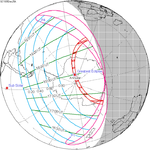 Annular |
−0.9228 | 126 | June 19, 1936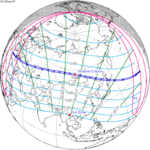 Total |
0.5389 | |
| 131 | December 13, 1936 Annular |
−0.2493 | 136 Totality in Kanton Island, Kiribati |
June 8, 1937 Total |
−0.2253 | |
| 141 | December 2, 1937 Annular |
0.4389 | 146 | May 29, 1938 Total |
−0.9607 | |
| 151 | November 21, 1938 Partial |
1.1077 | ||||
This eclipse is a member of a semester series. An eclipse in a semester series of solar eclipses repeats approximately every 177 days and 4 hours (a semester) at alternating nodes of the Moon's orbit.[12]
The partial solar eclipse on August 12, 1942 occurs in the next lunar year eclipse set.
| Solar eclipse series sets from 1939 to 1942 | ||||||
|---|---|---|---|---|---|---|
| Descending node | Ascending node | |||||
| Saros | Map | Gamma | Saros | Map | Gamma | |
| 118 | April 19, 1939 Annular |
0.9388 | 123 | October 12, 1939 Total |
−0.9737 | |
| 128 | April 7, 1940 Annular |
0.219 | 133 | October 1, 1940 Total |
−0.2573 | |
| 138 | March 27, 1941 Annular |
−0.5025 | 143 | September 21, 1941 Total |
0.4649 | |
| 148 | March 16, 1942 Partial |
−1.1908 | 153 | September 10, 1942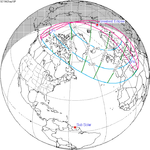 Partial |
1.2571 | |
This eclipse is a member of a semester series. An eclipse in a semester series of solar eclipses repeats approximately every 177 days and 4 hours (a semester) at alternating nodes of the Moon's orbit.[13]
The partial solar eclipses on March 16, 1942 and September 10, 1942 occur in the previous lunar year eclipse set, and the partial solar eclipses on May 30, 1946 and November 23, 1946 occur in the next lunar year eclipse set.
| Solar eclipse series sets from 1942 to 1946 | ||||||
|---|---|---|---|---|---|---|
| Ascending node | Descending node | |||||
| Saros | Map | Gamma | Saros | Map | Gamma | |
| 115 | August 12, 1942 Partial |
−1.5244 | 120 | February 4, 1943 Total |
0.8734 | |
| 125 | August 1, 1943 Annular |
−0.8041 | 130 | January 25, 1944 Total |
0.2025 | |
| 135 | July 20, 1944 Annular |
−0.0314 | 140 | January 14, 1945 Annular |
−0.4937 | |
| 145 | July 9, 1945 Total |
0.7356 | 150 | January 3, 1946 Partial |
−1.2392 | |
| 155 | June 29, 1946 Partial |
1.4361 | ||||
This eclipse is a member of a semester series. An eclipse in a semester series of solar eclipses repeats approximately every 177 days and 4 hours (a semester) at alternating nodes of the Moon's orbit.[14]
The partial solar eclipses on January 3, 1946 and June 29, 1946 occur in the previous lunar year eclipse set.
| Solar eclipse series sets from 1946 to 1949 | ||||||
|---|---|---|---|---|---|---|
| Ascending node | Descending node | |||||
| Saros | Map | Gamma | Saros | Map | Gamma | |
| 117 | May 30, 1946 Partial |
−1.0711 | 122 | November 23, 1946 Partial |
1.105 | |
| 127 | May 20, 1947 Total |
−0.3528 | 132 | November 12, 1947 Annular |
0.3743 | |
| 137 | May 9, 1948 Annular |
0.4133 | 142 | November 1, 1948 Total |
−0.3517 | |
| 147 | April 28, 1949 Partial |
1.2068 | 152 | October 21, 1949 Partial |
−1.027 | |
This eclipse is a member of a semester series. An eclipse in a semester series of solar eclipses repeats approximately every 177 days and 4 hours (a semester) at alternating nodes of the Moon's orbit.[15]
The partial solar eclipse on July 11, 1953 occurs in the next lunar year eclipse set.
| Solar eclipse series sets from 1950 to 1953 | ||||||
|---|---|---|---|---|---|---|
| Ascending node | Descending node | |||||
| Saros | Map | Gamma | Saros | Map | Gamma | |
| 119 | March 18, 1950 Annular (non-central) |
0.9988 | 124 | September 12, 1950 Total |
0.8903 | |
| 129 | March 7, 1951 Annular |
−0.242 | 134 | September 1, 1951 Annular |
0.1557 | |
| 139 | February 25, 1952 Total |
0.4697 | 144 | August 20, 1952 Annular |
−0.6102 | |
| 149 | February 14, 1953 Partial |
1.1331 | 154 | August 9, 1953 Partial |
−1.344 | |
This eclipse is a member of a semester series. An eclipse in a semester series of solar eclipses repeats approximately every 177 days and 4 hours (a semester) at alternating nodes of the Moon's orbit.[16]
The partial solar eclipses on February 14, 1953 and August 9, 1953 occur in the previous lunar year eclipse set.
| Solar eclipse series sets from 1953 to 1956 | ||||||
|---|---|---|---|---|---|---|
| Descending node | Ascending node | |||||
| Saros | Map | Gamma | Saros | Map | Gamma | |
| 116 | July 11, 1953 Partial |
1.4388 | 121 | January 5, 1954 Annular |
−0.9296 | |
| 126 | June 30, 1954 Total |
0.6135 | 131 | December 25, 1954 Annular |
−0.2576 | |
| 136 | June 20, 1955 Total |
−0.1528 | 141 | December 14, 1955 Annular |
0.4266 | |
| 146 | June 8, 1956 Total |
−0.8934 | 151 | December 2, 1956 Partial |
1.0923 | |
This eclipse is a member of a semester series. An eclipse in a semester series of solar eclipses repeats approximately every 177 days and 4 hours (a semester) at alternating nodes of the Moon's orbit.[17]
| Solar eclipse series sets from 1957 to 1960 | ||||||
|---|---|---|---|---|---|---|
| Descending node | Ascending node | |||||
| Saros | Map | Gamma | Saros | Map | Gamma | |
| 118 | April 30, 1957 Annular (non-central) |
0.9992 | 123 | October 23, 1957 Total (non-central) |
1.0022 | |
| 128 | April 19, 1958 Annular |
0.275 | 133 | October 12, 1958 Total |
−0.2951 | |
| 138 | April 8, 1959 Annular |
−0.4546 | 143 | October 2, 1959 Total |
0.4207 | |
| 148 | March 27, 1960 Partial |
−1.1537 | 153 | September 20, 1960 Partial |
1.2057 | |
This eclipse is a member of a semester series. An eclipse in a semester series of solar eclipses repeats approximately every 177 days and 4 hours (a semester) at alternating nodes of the Moon's orbit.[18]
The partial solar eclipses on June 10, 1964 and December 4, 1964 occur in the next lunar year eclipse set.
| Solar eclipse series sets from 1961 to 1964 | ||||||
|---|---|---|---|---|---|---|
| Descending node | Ascending node | |||||
| Saros | Map | Gamma | Saros | Map | Gamma | |
120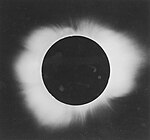
|
February 15, 1961 Total |
0.883 | 125 | August 11, 1961 Annular |
−0.8859 | |
| 130 | February 5, 1962 Total |
0.2107 | 135 | July 31, 1962 Annular |
−0.113 | |
| 140 | January 25, 1963 Annular |
−0.4898 | 145 | July 20, 1963 Total |
0.6571 | |
| 150 | January 14, 1964 Partial |
−1.2354 | 155 | July 9, 1964 Partial |
1.3623 | |
This eclipse is a member of a semester series. An eclipse in a semester series of solar eclipses repeats approximately every 177 days and 4 hours (a semester) at alternating nodes of the Moon's orbit.[19]
The partial solar eclipses on January 14, 1964 and July 9, 1964 occur in the previous lunar year eclipse set.
| Solar eclipse series sets from 1964 to 1967 | ||||||
|---|---|---|---|---|---|---|
| Ascending node | Descending node | |||||
| Saros | Map | Gamma | Saros | Map | Gamma | |
| 117 | June 10, 1964 Partial |
−1.1393 | 122 | December 4, 1964 Partial |
1.1193 | |
| 127 | May 30, 1965 Total |
−0.4225 | 132 | November 23, 1965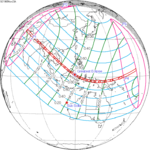 Annular |
0.3906 | |
| 137 | May 20, 1966 Annular |
0.3467 | 142 | November 12, 1966 Total |
−0.33 | |
| 147 | May 9, 1967 Partial |
1.1422 | 152 | November 2, 1967 Total (non-central) |
1.0007 | |
This eclipse is a member of a semester series. An eclipse in a semester series of solar eclipses repeats approximately every 177 days and 4 hours (a semester) at alternating nodes of the Moon's orbit.[20]
The partial solar eclipse on July 22, 1971 occurs in the next lunar year eclipse set.
| Solar eclipse series sets from 1968 to 1971 | ||||||
|---|---|---|---|---|---|---|
| Ascending node | Descending node | |||||
| Saros | Map | Gamma | Saros | Map | Gamma | |
| 119 | March 28, 1968 Partial |
−1.037 | 124 | September 22, 1968 Total |
0.9451 | |
| 129 | March 18, 1969 Annular |
−0.2704 | 134 | September 11, 1969 Annular |
0.2201 | |
139 Totality in Williamston, NC USA |
March 7, 1970 Total |
0.4473 | 144 | August 31, 1970 Annular |
−0.5364 | |
| 149 | February 25, 1971 Partial |
1.1188 | 154 | August 20, 1971 Partial |
−1.2659 | |
This eclipse is a member of a semester series. An eclipse in a semester series of solar eclipses repeats approximately every 177 days and 4 hours (a semester) at alternating nodes of the Moon's orbit.[21]
The partial solar eclipses on February 25, 1971 and August 20, 1971 occur in the previous lunar year eclipse set.
| Solar eclipse series sets from 1971 to 1974 | ||||||
|---|---|---|---|---|---|---|
| Descending node | Ascending node | |||||
| Saros | Map | Gamma | Saros | Map | Gamma | |
| 116 | July 22, 1971 Partial |
1.513 | 121 | January 16, 1972 Annular |
−0.9365 | |
| 126 | July 10, 1972 Total |
0.6872 | 131 | January 4, 1973 Annular |
−0.2644 | |
| 136 | June 30, 1973 Total |
−0.0785 | 141 | December 24, 1973 Annular |
0.4171 | |
| 146 | June 20, 1974 Total |
−0.8239 | 151 | December 13, 1974 Partial |
1.0797 | |
This eclipse is a member of a semester series. An eclipse in a semester series of solar eclipses repeats approximately every 177 days and 4 hours (a semester) at alternating nodes of the Moon's orbit.[22]
| Solar eclipse series sets from 1975 to 1978 | ||||||
|---|---|---|---|---|---|---|
| Descending node | Ascending node | |||||
| Saros | Map | Gamma | Saros | Map | Gamma | |
| 118 | May 11, 1975 Partial |
1.0647 | 123 | November 3, 1975 Partial |
−1.0248 | |
| 128 | April 29, 1976 Annular |
0.3378 | 133 | October 23, 1976 Total |
−0.327 | |
| 138 | April 18, 1977 Annular |
−0.399 | 143 | October 12, 1977 Total |
0.3836 | |
| 148 | April 7, 1978 Partial |
−1.1081 | 153 | October 2, 1978 Partial |
1.1616 | |
This eclipse is a member of a semester series. An eclipse in a semester series of solar eclipses repeats approximately every 177 days and 4 hours (a semester) at alternating nodes of the Moon's orbit.[23]
The partial solar eclipses on June 21, 1982 and December 15, 1982 occur in the next lunar year eclipse set.
| Solar eclipse series sets from 1979 to 1982 | ||||||
|---|---|---|---|---|---|---|
| Descending node | Ascending node | |||||
| Saros | Map | Gamma | Saros | Map | Gamma | |
120 Totality in Brandon, MB, Canada |
February 26, 1979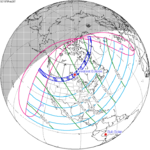 Total |
0.8981 | 125 | August 22, 1979 Annular |
−0.9632 | |
| 130 | February 16, 1980 Total |
0.2224 | 135 | August 10, 1980 Annular |
−0.1915 | |
| 140 | February 4, 1981 Annular |
−0.4838 | 145 | July 31, 1981 Total |
0.5792 | |
| 150 | January 25, 1982 Partial |
−1.2311 | 155 | July 20, 1982 Partial |
1.2886 | |
This eclipse is a member of a semester series. An eclipse in a semester series of solar eclipses repeats approximately every 177 days and 4 hours (a semester) at alternating nodes of the Moon's orbit.[24]
The partial solar eclipses on January 25, 1982 and July 20, 1982 occur in the previous lunar year eclipse set.
| Solar eclipse series sets from 1982 to 1985 | ||||||
|---|---|---|---|---|---|---|
| Ascending node | Descending node | |||||
| Saros | Map | Gamma | Saros | Map | Gamma | |
| 117 | June 21, 1982 Partial |
−1.2102 | 122 | December 15, 1982 Partial |
1.1293 | |
| 127 | June 11, 1983 Total |
−0.4947 | 132 | December 4, 1983 Annular |
0.4015 | |
| 137 | May 30, 1984 Annular |
0.2755 | 142 Partial in Gisborne, New Zealand |
November 22, 1984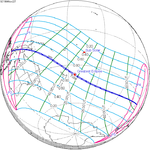 Total |
−0.3132 | |
| 147 | May 19, 1985 Partial |
1.072 | 152 | November 12, 1985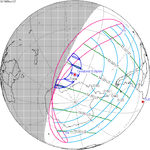 Total |
−0.9795 | |
This eclipse is a member of a semester series. An eclipse in a semester series of solar eclipses repeats approximately every 177 days and 4 hours (a semester) at alternating nodes of the Moon's orbit.[25]
| Solar eclipse series sets from 1986 to 1989 | ||||||
|---|---|---|---|---|---|---|
| Ascending node | Descending node | |||||
| Saros | Map | Gamma | Saros | Map | Gamma | |
| 119 | April 9, 1986 Partial |
−1.0822 | 124 | October 3, 1986 Hybrid |
0.9931 | |
| 129 | March 29, 1987 Hybrid |
−0.3053 | 134 | September 23, 1987 Annular |
0.2787 | |
| 139 | March 18, 1988 Total |
0.4188 | 144 | September 11, 1988 Annular |
−0.4681 | |
| 149 | March 7, 1989 Partial |
1.0981 | 154 | August 31, 1989 Partial |
−1.1928 | |
This eclipse is a member of a semester series. An eclipse in a semester series of solar eclipses repeats approximately every 177 days and 4 hours (a semester) at alternating nodes of the Moon's orbit.[26]
| Solar eclipse series sets from 1990 to 1992 | ||||||
|---|---|---|---|---|---|---|
| Ascending node | Descending node | |||||
| Saros | Map | Gamma | Saros | Map | Gamma | |
| 121 | January 26, 1990 Annular |
−0.9457 | 126 Partial in Finland |
July 22, 1990 Total |
0.7597 | |
| 131 | January 15, 1991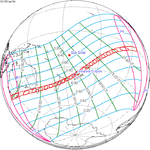 Annular |
−0.2727 | 136 Totality in Playas del Coco, Costa Rica |
July 11, 1991 Total |
−0.0041 | |
| 141 | January 4, 1992 Annular |
0.4091 | 146 | June 30, 1992 Total |
−0.7512 | |
| 151 | December 24, 1992 Partial |
1.0711 | ||||
This eclipse is a member of a semester series. An eclipse in a semester series of solar eclipses repeats approximately every 177 days and 4 hours (a semester) at alternating nodes of the Moon's orbit.[27]
| Solar eclipse series sets from 1993 to 1996 | ||||||
|---|---|---|---|---|---|---|
| Descending node | Ascending node | |||||
| Saros | Map | Gamma | Saros | Map | Gamma | |
| 118 | May 21, 1993 Partial |
1.1372 | 123 | November 13, 1993 Partial |
−1.0411 | |
128 Partial in Bismarck, ND, USA |
May 10, 1994 Annular |
0.4077 | 133 Totality in Bolivia |
November 3, 1994 Total |
−0.3522 | |
| 138 | April 29, 1995 Annular |
−0.3382 | 143 Totality in Dundlod, India |
October 24, 1995 Total |
0.3518 | |
| 148 | April 17, 1996 Partial |
−1.058 | 153 | October 12, 1996 Partial |
1.1227 | |
This eclipse is a member of a semester series. An eclipse in a semester series of solar eclipses repeats approximately every 177 days and 4 hours (a semester) at alternating nodes of the Moon's orbit.[28]
The partial solar eclipses on July 1, 2000 and December 25, 2000 occur in the next lunar year eclipse set.
| Solar eclipse series sets from 1997 to 2000 | ||||||
|---|---|---|---|---|---|---|
| Descending node | Ascending node | |||||
| Saros | Map | Gamma | Saros | Map | Gamma | |
120 Totality in Chita, Russia |
March 9, 1997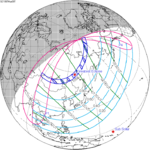 Total |
0.9183 | 125 | September 2, 1997 Partial |
−1.0352 | |
130 Totality near Guadeloupe |
February 26, 1998 Total |
0.2391 | 135 | August 22, 1998 Annular |
−0.2644 | |
| 140 | February 16, 1999 Annular |
−0.4726 | 145 Totality in France |
August 11, 1999 Total |
0.5062 | |
| 150 | February 5, 2000 Partial |
−1.2233 | 155 | July 31, 2000 Partial |
1.2166 | |
This eclipse is a member of a semester series. An eclipse in a semester series of solar eclipses repeats approximately every 177 days and 4 hours (a semester) at alternating nodes of the Moon's orbit.[29]
The partial solar eclipses on February 5, 2000 and July 31, 2000 occur in the previous lunar year eclipse set.
| Solar eclipse series sets from 2000 to 2003 | ||||||
|---|---|---|---|---|---|---|
| Ascending node | Descending node | |||||
| Saros | Map | Gamma | Saros | Map | Gamma | |
| 117 | July 1, 2000 Partial |
−1.28214 | 122 Partial projection in Minneapolis, MN, USA |
December 25, 2000 Partial |
1.13669 | |
127 Totality in Lusaka, Zambia |
June 21, 2001 Total |
−0.57013 | 132 Partial in Minneapolis, MN, USA |
December 14, 2001 Annular |
0.40885 | |
137 Partial in Los Angeles, CA, USA |
June 10, 2002 Annular |
0.19933 | 142 Totality in Woomera, South Australia |
December 4, 2002 Total |
−0.30204 | |
147 Annularity in Culloden, Scotland |
May 31, 2003 Annular |
0.99598 | 152
|
November 23, 2003 Total |
−0.96381 | |
This eclipse is a member of a semester series. An eclipse in a semester series of solar eclipses repeats approximately every 177 days and 4 hours (a semester) at alternating nodes of the Moon's orbit.[30]
| Solar eclipse series sets from 2004 to 2007 | ||||||
|---|---|---|---|---|---|---|
| Ascending node | Descending node | |||||
| Saros | Map | Gamma | Saros | Map | Gamma | |
| 119 | April 19, 2004 Partial |
−1.13345 | 124 | October 14, 2004 Partial |
1.03481 | |
129 Partial in Naiguatá, Venezuela |
April 8, 2005 Hybrid |
−0.34733 | 134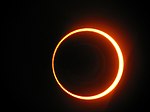 Annularity in Madrid, Spain |
October 3, 2005 Annular |
0.33058 | |
139 Totality in Side, Turkey |
March 29, 2006 Total |
0.38433 | 144 Partial in São Paulo, Brazil |
September 22, 2006 Annular |
−0.40624 | |
149 Partial in Jaipur, India |
March 19, 2007 Partial |
1.07277 | 154 Partial in Córdoba, Argentina |
September 11, 2007 Partial |
−1.12552 | |
This eclipse is a member of a semester series. An eclipse in a semester series of solar eclipses repeats approximately every 177 days and 4 hours (a semester) at alternating nodes of the Moon's orbit.[31]
The partial solar eclipses on June 1, 2011 and November 25, 2011 occur in the next lunar year eclipse set.
| Solar eclipse series sets from 2008 to 2011 | ||||||
|---|---|---|---|---|---|---|
| Ascending node | Descending node | |||||
| Saros | Map | Gamma | Saros | Map | Gamma | |
121 Partial in Christchurch, New Zealand |
February 7, 2008 Annular |
−0.95701 | 126 Totality in Kumul, Xinjiang, China |
August 1, 2008 Total |
0.83070 | |
131 Annularity in Palangka Raya, Indonesia |
January 26, 2009 Annular |
−0.28197 | 136 Totality in Kurigram District, Bangladesh |
July 22, 2009 Total |
0.06977 | |
141 Annularity in Jinan, Shandong, China |
January 15, 2010 Annular |
0.40016 | 146 Totality in Hao, French Polynesia |
July 11, 2010 Total |
−0.67877 | |
151 Partial in Poland |
January 4, 2011 Partial |
1.06265 | 156 | July 1, 2011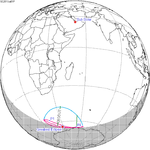 Partial |
−1.49171 | |
This eclipse is a member of a semester series. An eclipse in a semester series of solar eclipses repeats approximately every 177 days and 4 hours (a semester) at alternating nodes of the Moon's orbit.[32]
The partial solar eclipses on January 4, 2011 and July 1, 2011 occur in the previous lunar year eclipse set.
| Solar eclipse series sets from 2011 to 2014 | ||||||
|---|---|---|---|---|---|---|
| Descending node | Ascending node | |||||
| Saros | Map | Gamma | Saros | Map | Gamma | |
118 Partial in Tromsø, Norway |
June 1, 2011 Partial |
1.21300 | 123 Hinode XRT footage |
November 25, 2011 Partial |
−1.05359 | |
128 Annularity in Red Bluff, CA, USA |
May 20, 2012 Annular |
0.48279 | 133 Totality in Mount Carbine, Queensland, Australia |
November 13, 2012 Total |
−0.37189 | |
138 Annularity in Churchills Head, Australia |
May 10, 2013 Annular |
−0.26937 | 143 Partial in Libreville, Gabon |
November 3, 2013 Hybrid |
0.32715 | |
148 Partial in Adelaide, Australia |
April 29, 2014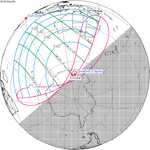 Annular (non-central) |
−0.99996 | 153 Partial in Minneapolis, MN, USA |
October 23, 2014 Partial |
1.09078 | |
This eclipse is a member of a semester series. An eclipse in a semester series of solar eclipses repeats approximately every 177 days and 4 hours (a semester) at alternating nodes of the Moon's orbit.[33]
The partial solar eclipse on July 13, 2018 occurs in the next lunar year eclipse set.
| Solar eclipse series sets from 2015 to 2018 | ||||||
|---|---|---|---|---|---|---|
| Descending node | Ascending node | |||||
| Saros | Map | Gamma | Saros | Map | Gamma | |
120 Totality in Longyearbyen, Svalbard |
March 20, 2015 Total |
0.94536 | 125 Solar Dynamics Observatory |
September 13, 2015  Partial |
−1.10039 | |
130 Balikpapan, Indonesia |
March 9, 2016 Total |
0.26092 | 135 Annularity in L'Étang-Salé, Réunion |
September 1, 2016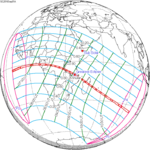 Annular |
−0.33301 | |
140 Partial from Buenos Aires, Argentina |
February 26, 2017 Annular |
−0.45780 | 145 Totality in Madras, OR, USA |
August 21, 2017 Total |
0.43671 | |
150 Partial in Olivos, Buenos Aires, Argentina |
February 15, 2018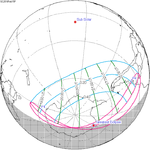 Partial |
−1.21163 | 155 Partial in Huittinen, Finland |
August 11, 2018 Partial |
1.14758 | |
This eclipse is a member of a semester series. An eclipse in a semester series of solar eclipses repeats approximately every 177 days and 4 hours (a semester) at alternating nodes of the Moon's orbit.[34]
The partial solar eclipses on February 15, 2018 and August 11, 2018 occur in the previous lunar year eclipse set.
| Solar eclipse series sets from 2018 to 2021 | ||||||
|---|---|---|---|---|---|---|
| Ascending node | Descending node | |||||
| Saros | Map | Gamma | Saros | Map | Gamma | |
117 Partial in Melbourne, Australia |
July 13, 2018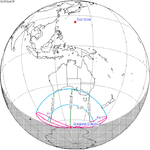 Partial |
−1.35423 | 122 Partial in Nakhodka, Russia |
January 6, 2019 Partial |
1.14174 | |
127 Totality in La Serena, Chile |
July 2, 2019 Total |
−0.64656 | 132 Annularity in Jaffna, Sri Lanka |
December 26, 2019 Annular |
0.41351 | |
137 Annularity in Beigang, Yunlin, Taiwan |
June 21, 2020 Annular |
0.12090 | 142 Totality in Gorbea, Chile |
December 14, 2020 Total |
−0.29394 | |
147 Partial in Halifax, Canada |
June 10, 2021 Annular |
0.91516 | 152 From HMS Protector off South Georgia |
December 4, 2021 Total |
−0.95261 | |
This eclipse is a member of a semester series. An eclipse in a semester series of solar eclipses repeats approximately every 177 days and 4 hours (a semester) at alternating nodes of the Moon's orbit.[35]
| Solar eclipse series sets from 2022 to 2025 | ||||||
|---|---|---|---|---|---|---|
| Ascending node | Descending node | |||||
| Saros | Map | Gamma | Saros | Map | Gamma | |
119 Partial in CTIO, Chile |
April 30, 2022 Partial |
−1.19008 | 124 Partial from Saratov, Russia |
October 25, 2022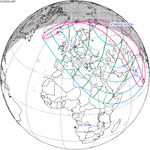 Partial |
1.07014 | |
129 Partial in Magetan, Indonesia |
April 20, 2023 Hybrid |
−0.39515 | 134 Annularity in Hobbs, NM, USA |
October 14, 2023 Annular |
0.37534 | |
139 Totality in Dallas, TX, USA |
April 8, 2024 Total |
0.34314 | 144 Annularity in Santa Cruz Province, Argentina |
October 2, 2024 Annular |
−0.35087 | |
| 149 | March 29, 2025 Partial |
1.04053 | 154 | September 21, 2025 Partial |
−1.06509 | |
This eclipse is a member of a semester series. An eclipse in a semester series of solar eclipses repeats approximately every 177 days and 4 hours (a semester) at alternating nodes of the Moon's orbit.[36]
The partial solar eclipses on June 12, 2029 and December 5, 2029 occur in the next lunar year eclipse set.
| Solar eclipse series sets from 2026 to 2029 | ||||||
|---|---|---|---|---|---|---|
| Ascending node | Descending node | |||||
| Saros | Map | Gamma | Saros | Map | Gamma | |
| 121 | February 17, 2026 Annular |
−0.97427 | 126 | August 12, 2026 Total |
0.89774 | |
| 131 | February 6, 2027 Annular |
−0.29515 | 136 | August 2, 2027 Total |
0.14209 | |
| 141 | January 26, 2028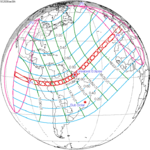 Annular |
0.39014 | 146 | July 22, 2028 Total |
−0.60557 | |
| 151 | January 14, 2029 Partial |
1.05532 | 156 | July 11, 2029 Partial |
−1.41908 | |
This eclipse is a member of a semester series. An eclipse in a semester series of solar eclipses repeats approximately every 177 days and 4 hours (a semester) at alternating nodes of the Moon's orbit.[37]
The partial solar eclipses on January 14, 2029 and July 11, 2029 occur in the previous lunar year eclipse set.
| Solar eclipse series sets from 2029 to 2032 | ||||||
|---|---|---|---|---|---|---|
| Descending node | Ascending node | |||||
| Saros | Map | Gamma | Saros | Map | Gamma | |
| 118 | June 12, 2029 Partial |
1.29431 | 123 | December 5, 2029 Partial |
−1.06090 | |
| 128 | June 1, 2030 Annular |
0.56265 | 133 | November 25, 2030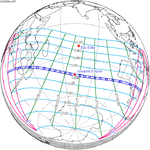 Total |
−0.38669 | |
| 138 | May 21, 2031 Annular |
−0.19699 | 143 | November 14, 2031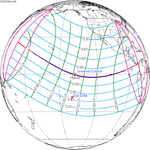 Hybrid |
0.30776 | |
| 148 | May 9, 2032 Annular |
−0.93748 | 153 | November 3, 2032 Partial |
1.06431 | |
This eclipse is a member of a semester series. An eclipse in a semester series of solar eclipses repeats approximately every 177 days and 4 hours (a semester) at alternating nodes of the Moon's orbit.[38]
The partial solar eclipse on July 23, 2036 occurs in the next lunar year eclipse set.
| Solar eclipse series sets from 2033 to 2036 | ||||||
|---|---|---|---|---|---|---|
| Descending node | Ascending node | |||||
| Saros | Map | Gamma | Saros | Map | Gamma | |
| 120 | March 30, 2033 Total |
0.9778 | 125 | September 23, 2033 Partial |
−1.1583 | |
| 130 | March 20, 2034 Total |
0.2894 | 135 | September 12, 2034 Annular |
−0.3936 | |
| 140 | March 9, 2035 Annular |
−0.4368 | 145 | September 2, 2035 Total |
0.3727 | |
| 150 | February 27, 2036 Partial |
−1.1942 | 155 | August 21, 2036 Partial |
1.0825 | |
This eclipse is a member of a semester series. An eclipse in a semester series of solar eclipses repeats approximately every 177 days and 4 hours (a semester) at alternating nodes of the Moon's orbit.[39]
The partial solar eclipses on February 27, 2036 and August 21, 2036 occur in the previous lunar year eclipse set.
| Solar eclipse series sets from 2036 to 2039 | ||||||
|---|---|---|---|---|---|---|
| Ascending node | Descending node | |||||
| Saros | Map | Gamma | Saros | Map | Gamma | |
| 117 | July 23, 2036 Partial |
−1.425 | 122 | January 16, 2037 Partial |
1.1477 | |
| 127 | July 13, 2037 Total |
−0.7246 | 132 | January 5, 2038 Annular |
0.4169 | |
| 137 | July 2, 2038 Annular |
0.0398 | 142 | December 26, 2038 Total |
−0.2881 | |
| 147 | June 21, 2039 Annular |
0.8312 | 152 | December 15, 2039 Total |
−0.9458 | |
This eclipse is a member of a semester series. An eclipse in a semester series of solar eclipses repeats approximately every 177 days and 4 hours (a semester) at alternating nodes of the Moon's orbit.[40]
| Solar eclipse series sets from 2040 to 2043 | ||||||
|---|---|---|---|---|---|---|
| Ascending node | Descending node | |||||
| Saros | Map | Gamma | Saros | Map | Gamma | |
| 119 | May 11, 2040 Partial |
−1.2529 | 124 | November 4, 2040 Partial |
1.0993 | |
| 129 | April 30, 2041 Total |
−0.4492 | 134 | October 25, 2041 Annular |
0.4133 | |
| 139 | April 20, 2042 Total |
0.2956 | 144 | October 14, 2042 Annular |
−0.303 | |
| 149 | April 9, 2043 Total (non-central) |
1.0031 | 154 | October 3, 2043 Annular (non-central) |
1.0102 | |
This eclipse is a member of a semester series. An eclipse in a semester series of solar eclipses repeats approximately every 177 days and 4 hours (a semester) at alternating nodes of the Moon's orbit.[41]
The partial solar eclipses on June 23, 2047 and December 16, 2047 occur in the next lunar year eclipse set.
| Solar eclipse series sets from 2044 to 2047 | ||||||
|---|---|---|---|---|---|---|
| Ascending node | Descending node | |||||
| Saros | Map | Gamma | Saros | Map | Gamma | |
| 121 | February 28, 2044 Annular |
−0.9954 | 126 | August 23, 2044 Total |
0.9613 | |
| 131 | February 16, 2045 Annular |
−0.3125 | 136 | August 12, 2045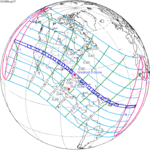 Total |
0.2116 | |
| 141 | February 5, 2046 Annular |
0.3765 | 146 | August 2, 2046 Total |
−0.535 | |
| 151 | January 26, 2047 Partial |
1.045 | 156 | July 22, 2047 Partial |
−1.3477 | |
This eclipse is a member of a semester series. An eclipse in a semester series of solar eclipses repeats approximately every 177 days and 4 hours (a semester) at alternating nodes of the Moon's orbit.[42]
The partial solar eclipses on January 26, 2047 and July 22, 2047 occur in the previous lunar year eclipse set.
| Solar eclipse series sets from 2047 to 2050 | ||||||
|---|---|---|---|---|---|---|
| Descending node | Ascending node | |||||
| Saros | Map | Gamma | Saros | Map | Gamma | |
| 118 | June 23, 2047 Partial |
1.3766 | 123 | December 16, 2047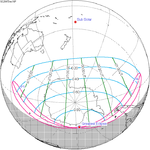 Partial |
−1.0661 | |
| 128 | June 11, 2048 Annular |
0.6468 | 133 | December 5, 2048 Total |
−0.3973 | |
| 138 | May 31, 2049 Annular |
−0.1187 | 143 | November 25, 2049 Hybrid |
0.2943 | |
| 148 | May 20, 2050 Hybrid |
−0.8688 | 153 | November 14, 2050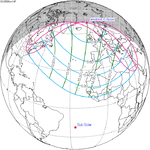 Partial |
1.0447 | |
This eclipse is a member of a semester series. An eclipse in a semester series of solar eclipses repeats approximately every 177 days and 4 hours (a semester) at alternating nodes of the Moon's orbit.[43]
The partial solar eclipse on August 3, 2054 occurs in the next lunar year eclipse set.
| Solar eclipse series sets from 2051 to 2054 | ||||||
|---|---|---|---|---|---|---|
| Descending node | Ascending node | |||||
| Saros | Map | Gamma | Saros | Map | Gamma | |
| 120 | April 11, 2051 Partial |
1.0169 | 125 | October 4, 2051 Partial |
−1.2094 | |
| 130 | March 30, 2052 Total |
0.3238 | 135 | September 22, 2052 Annular |
−0.448 | |
| 140 | March 20, 2053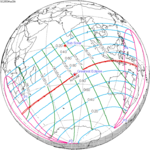 Annular |
−0.4089 | 145 | September 12, 2053 Total |
0.314 | |
| 150 | March 9, 2054 Partial |
−1.1711 | 155 | September 2, 2054 Partial |
1.0215 | |
This eclipse is a member of a semester series. An eclipse in a semester series of solar eclipses repeats approximately every 177 days and 4 hours (a semester) at alternating nodes of the Moon's orbit.[44]
The partial solar eclipses on March 9, 2054 and September 2, 2054 occur in the previous lunar year eclipse set, and the partial solar eclipses on May 22, 2058 and November 16, 2058 occur in the next lunar year eclipse set.
| Solar eclipse series sets from 2054 to 2058 | ||||||
|---|---|---|---|---|---|---|
| Ascending node | Descending node | |||||
| Saros | Map | Gamma | Saros | Map | Gamma | |
| 117 | August 3, 2054 Partial |
−1.4941 | 122 | January 27, 2055 Partial |
1.155 | |
| 127 | July 24, 2055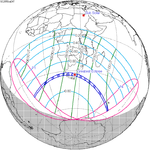 Total |
−0.8012 | 132 | January 16, 2056 Annular |
0.4199 | |
| 137 | July 12, 2056 Annular |
−0.0426 | 142 | January 5, 2057 Total |
−0.2837 | |
| 147 | July 1, 2057 Annular |
0.7455 | 152 | December 26, 2057 Total |
−0.9405 | |
| 157 | June 21, 2058 Partial |
1.4869 | ||||
This eclipse is a member of a semester series. An eclipse in a semester series of solar eclipses repeats approximately every 177 days and 4 hours (a semester) at alternating nodes of the Moon's orbit.[45]
The partial solar eclipse on June 21, 2058 occurs in the previous lunar year eclipse set.
| Solar eclipse series sets from 2058 to 2061 | ||||||
|---|---|---|---|---|---|---|
| Ascending node | Descending node | |||||
| Saros | Map | Gamma | Saros | Map | Gamma | |
| 119 | May 22, 2058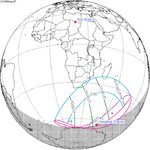 Partial |
−1.3194 | 124 | November 16, 2058 Partial |
1.1224 | |
| 129 | May 11, 2059 Total |
−0.508 | 134 | November 5, 2059 Annular |
0.4454 | |
| 139 | April 30, 2060 Total |
0.2422 | 144 | October 24, 2060 Annular |
−0.2625 | |
| 149 | April 20, 2061 Total |
0.9578 | 154 | October 13, 2061 Annular |
−0.9639 | |
This eclipse is a member of a semester series. An eclipse in a semester series of solar eclipses repeats approximately every 177 days and 4 hours (a semester) at alternating nodes of the Moon's orbit.[46]
The partial solar eclipses on July 3, 2065 and December 27, 2065 occur in the next lunar year eclipse set.
| Solar eclipse series sets from 2062 to 2065 | ||||||
|---|---|---|---|---|---|---|
| Ascending node | Descending node | |||||
| Saros | Map | Gamma | Saros | Map | Gamma | |
| 121 | March 11, 2062 Partial |
−1.0238 | 126 | September 3, 2062 Partial |
1.0191 | |
| 131 | February 28, 2063 Annular |
−0.336 | 136 | August 24, 2063 Total |
0.2771 | |
| 141 | February 17, 2064 Annular |
0.3597 | 146 | August 12, 2064 Total |
−0.4652 | |
| 151 | February 5, 2065 Partial |
1.0336 | 156 | August 2, 2065 Partial |
−1.2759 | |
This eclipse is a member of a semester series. An eclipse in a semester series of solar eclipses repeats approximately every 177 days and 4 hours (a semester) at alternating nodes of the Moon's orbit.[47]
The partial solar eclipses on February 5, 2065 and August 2, 2065 occur in the previous lunar year eclipse set, and the partial solar eclipses on April 21, 2069 and October 15, 2069 occur in the next lunar year eclipse set.
| Solar eclipse series sets from 2065 to 2069 | ||||||
|---|---|---|---|---|---|---|
| Descending node | Ascending node | |||||
| Saros | Map | Gamma | Saros | Map | Gamma | |
| 118 | July 3, 2065 Partial |
1.4619 | 123 | December 27, 2065 Partial |
−1.0688 | |
| 128 | June 22, 2066 Annular |
0.733 | 133 | December 17, 2066 Total |
−0.4043 | |
| 138 | June 11, 2067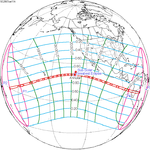 Annular |
−0.0387 | 143 | December 6, 2067 Hybrid |
0.2845 | |
| 148 | May 31, 2068 Total |
−0.797 | 153 | November 24, 2068 Partial |
1.0299 | |
| 158 | May 20, 2069 Partial |
−1.4852 | ||||
This eclipse is a member of a semester series. An eclipse in a semester series of solar eclipses repeats approximately every 177 days and 4 hours (a semester) at alternating nodes of the Moon's orbit.[48]
The partial solar eclipse on May 20, 2069 occurs in the previous lunar year eclipse set.
| Solar eclipse series sets from 2069 to 2072 | ||||||
|---|---|---|---|---|---|---|
| Descending node | Ascending node | |||||
| Saros | Map | Gamma | Saros | Map | Gamma | |
| 120 | April 21, 2069 Partial |
1.0624 | 125 | October 15, 2069 Partial |
−1.2524 | |
| 130 | April 11, 2070 Total |
0.3652 | 135 | October 4, 2070 Annular |
−0.495 | |
| 140 | March 31, 2071 Annular |
−0.3739 | 145 | September 23, 2071 Total |
0.262 | |
| 150 | March 19, 2072 Partial |
−1.1405 | 155 | September 12, 2072 Total |
0.9655 | |
This eclipse is a member of a semester series. An eclipse in a semester series of solar eclipses repeats approximately every 177 days and 4 hours (a semester) at alternating nodes of the Moon's orbit.[49]
The partial solar eclipses on June 1, 2076 and November 26, 2076 occur in the next lunar year eclipse set.
| Solar eclipse series sets from 2073 to 2076 | ||||||
|---|---|---|---|---|---|---|
| Descending node | Ascending node | |||||
| Saros | Map | Gamma | Saros | Map | Gamma | |
| 122 | February 7, 2073 Partial |
1.1651 | 127 | August 3, 2073 Total |
−0.8763 | |
| 132 | January 27, 2074 Annular |
0.4251 | 137 | July 24, 2074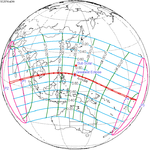 Annular |
−0.1242 | |
| 142 | January 16, 2075 Total |
−0.2799 | 147 | July 13, 2075 Annular |
0.6583 | |
| 152 | January 6, 2076 Total |
−0.9373 | 157 | July 1, 2076 Partial |
1.4005 | |
This eclipse is a member of a semester series. An eclipse in a semester series of solar eclipses repeats approximately every 177 days and 4 hours (a semester) at alternating nodes of the Moon's orbit.[50]
The partial solar eclipses on January 6, 2076 and July 1, 2076 occur in the previous lunar year eclipse set.
| Solar eclipse series sets from 2076 to 2079 | ||||||
|---|---|---|---|---|---|---|
| Ascending node | Descending node | |||||
| Saros | Map | Gamma | Saros | Map | Gamma | |
| 119 | June 1, 2076 Partial |
−1.3897 | 124 | November 26, 2076 Partial |
1.1401 | |
| 129 | May 22, 2077 Total |
−0.5725 | 134 | November 15, 2077 Annular |
0.4705 | |
| 139 | May 11, 2078 Total |
0.1838 | 144 | November 4, 2078 Annular |
−0.2285 | |
| 149 | May 1, 2079 Total |
0.9081 | 154 | October 24, 2079 Annular |
−0.9243 | |
This eclipse is a member of a semester series. An eclipse in a semester series of solar eclipses repeats approximately every 177 days and 4 hours (a semester) at alternating nodes of the Moon's orbit.[51]
The partial solar eclipse on July 15, 2083 occurs in the next lunar year eclipse set.
| Solar eclipse series sets from 2080 to 2083 | ||||||
|---|---|---|---|---|---|---|
| Ascending node | Descending node | |||||
| Saros | Map | Gamma | Saros | Map | Gamma | |
| 121 | March 21, 2080 Partial |
−1.0578 | 126 | September 13, 2080 Partial |
1.0723 | |
| 131 | March 10, 2081 Annular |
−0.3653 | 136 | September 3, 2081 Total |
0.3378 | |
| 141 | February 27, 2082 Annular |
0.3361 | 146 | August 24, 2082 Total |
−0.4004 | |
| 151 | February 16, 2083 Partial |
1.017 | 156 | August 13, 2083 Partial |
−1.2064 | |
This eclipse is a member of a semester series. An eclipse in a semester series of solar eclipses repeats approximately every 177 days and 4 hours (a semester) at alternating nodes of the Moon's orbit.[52]
The partial solar eclipses on February 16, 2083 and August 13, 2083 occur in the previous lunar year eclipse set, and the partial solar eclipses on May 2, 2087 and October 26, 2087 occur in the next lunar year eclipse set.
| Solar eclipse series sets from 2083 to 2087 | ||||||
|---|---|---|---|---|---|---|
| Descending node | Ascending node | |||||
| Saros | Map | Gamma | Saros | Map | Gamma | |
| 118 | July 15, 2083 Partial |
1.5465 | 123 | January 7, 2084 Partial |
−1.0715 | |
| 128 | July 3, 2084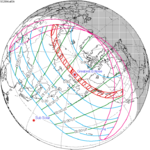 Annular |
0.8208 | 133 | December 27, 2084 Total |
−0.4094 | |
| 138 | June 22, 2085 Annular |
0.0452 | 143 | December 16, 2085 Annular |
0.2786 | |
| 148 | June 11, 2086 Total |
−0.7215 | 153 | December 6, 2086 Partial |
1.0194 | |
| 158 | June 1, 2087 Partial |
−1.4186 | ||||
This eclipse is a member of a semester series. An eclipse in a semester series of solar eclipses repeats approximately every 177 days and 4 hours (a semester) at alternating nodes of the Moon's orbit.[53]
The partial solar eclipse on June 1, 2087 occurs in the previous lunar year eclipse set.
| Solar eclipse series sets from 2087 to 2090 | ||||||
|---|---|---|---|---|---|---|
| Descending node | Ascending node | |||||
| Saros | Map | Gamma | Saros | Map | Gamma | |
| 120 | May 2, 2087 Partial |
1.1139 | 125 | October 26, 2087 Partial |
−1.2882 | |
| 130 | April 21, 2088 Total |
0.4135 | 135 | October 14, 2088 Annular |
−0.5349 | |
| 140 | April 10, 2089 Annular |
−0.3319 | 145 | October 4, 2089 Total |
0.2167 | |
| 150 | March 31, 2090 Partial |
−1.1028 | 155 | September 23, 2090 Total |
0.9157 | |
This eclipse is a member of a semester series. An eclipse in a semester series of solar eclipses repeats approximately every 177 days and 4 hours (a semester) at alternating nodes of the Moon's orbit.[54]
The partial solar eclipses on June 13, 2094 and December 7, 2094 occur in the next lunar year eclipse set.
| Solar eclipse series sets from 2091 to 2094 | ||||||
|---|---|---|---|---|---|---|
| Descending node | Ascending node | |||||
| Saros | Map | Gamma | Saros | Map | Gamma | |
| 122 | February 18, 2091 Partial |
1.1779 | 127 | August 15, 2091 Total |
−0.949 | |
| 132 | February 7, 2092 Annular |
0.4322 | 137 | August 3, 2092 Annular |
−0.2044 | |
| 142 | January 27, 2093 Total |
−0.2737 | 147 | July 23, 2093 Annular |
0.5717 | |
| 152 | January 16, 2094 Total |
−0.9333 | 157 | July 12, 2094 Partial |
1.3150 | |
This eclipse is a member of a semester series. An eclipse in a semester series of solar eclipses repeats approximately every 177 days and 4 hours (a semester) at alternating nodes of the Moon's orbit.[55]
The solar eclipses on January 16, 2094 (total) and July 12, 2094 (partial) occur in the previous lunar year eclipse set, and the partial solar eclipses on April 1, 2098 and September 25, 2098 occur in the next lunar year eclipse set.
| Solar eclipse series sets from 2094 to 2098 | ||||||
|---|---|---|---|---|---|---|
| Ascending node | Descending node | |||||
| Saros | Map | Gamma | Saros | Map | Gamma | |
| 119 | June 13, 2094 Partial |
−1.4613 | 124 | December 7, 2094 Partial |
1.1547 | |
| 129 | June 2, 2095 Total |
−0.6396 | 134 | November 27, 2095 Annular |
0.4903 | |
| 139 | May 22, 2096 Total |
0.1196 | 144 | November 15, 2096 Annular |
−0.20 | |
| 149 | May 11, 2097 Total |
0.8516 | 154 | November 4, 2097 Annular |
−0.8926 | |
| 159 | May 1, 2098 | 164 | October 24, 2098 Partial |
−1.5407 | ||
This eclipse is a member of a semester series. An eclipse in a semester series of solar eclipses repeats approximately every 177 days and 4 hours (a semester) at alternating nodes of the Moon's orbit.[56]
The partial solar eclipse on October 24, 2098 occurs in the previous lunar year eclipse set.
| Solar eclipse series sets from 2098 to 2101 | ||||||
|---|---|---|---|---|---|---|
| Ascending node | Descending node | |||||
| Saros | Map | Gamma | Saros | Map | Gamma | |
| 121 | April 1, 2098 Partial |
−1.1005 | 126 | September 25, 2098 Partial |
1.14 | |
| 131 | March 21, 2099 Annular |
−0.4016 | 136 | September 14, 2099 Total |
0.3942 | |
| 141 | March 10, 2100 Annular |
0.3077 | 146 | September 4, 2100 Total |
−0.3384 | |
| 151 | February 28, 2101 Annular |
0.9964 | 156 | August 24, 2101 Partial |
−1.1392 | |
- ^ van Gent, R.H. "Solar- and Lunar-Eclipse Predictions from Antiquity to the Present". A Catalogue of Eclipse Cycles. Utrecht University. Retrieved 6 October 2018.
- ^ van Gent, R.H. "Solar- and Lunar-Eclipse Predictions from Antiquity to the Present". A Catalogue of Eclipse Cycles. Utrecht University. Retrieved 6 October 2018.
- ^ van Gent, R.H. "Solar- and Lunar-Eclipse Predictions from Antiquity to the Present". A Catalogue of Eclipse Cycles. Utrecht University. Retrieved 6 October 2018.
- ^ van Gent, R.H. "Solar- and Lunar-Eclipse Predictions from Antiquity to the Present". A Catalogue of Eclipse Cycles. Utrecht University. Retrieved 6 October 2018.
- ^ van Gent, R.H. "Solar- and Lunar-Eclipse Predictions from Antiquity to the Present". A Catalogue of Eclipse Cycles. Utrecht University. Retrieved 6 October 2018.
- ^ van Gent, R.H. "Solar- and Lunar-Eclipse Predictions from Antiquity to the Present". A Catalogue of Eclipse Cycles. Utrecht University. Retrieved 6 October 2018.
- ^ van Gent, R.H. "Solar- and Lunar-Eclipse Predictions from Antiquity to the Present". A Catalogue of Eclipse Cycles. Utrecht University. Retrieved 6 October 2018.
- ^ van Gent, R.H. "Solar- and Lunar-Eclipse Predictions from Antiquity to the Present". A Catalogue of Eclipse Cycles. Utrecht University. Retrieved 6 October 2018.
- ^ van Gent, R.H. "Solar- and Lunar-Eclipse Predictions from Antiquity to the Present". A Catalogue of Eclipse Cycles. Utrecht University. Retrieved 6 October 2018.
- ^ van Gent, R.H. "Solar- and Lunar-Eclipse Predictions from Antiquity to the Present". A Catalogue of Eclipse Cycles. Utrecht University. Retrieved 6 October 2018.
- ^ van Gent, R.H. "Solar- and Lunar-Eclipse Predictions from Antiquity to the Present". A Catalogue of Eclipse Cycles. Utrecht University. Retrieved 6 October 2018.
- ^ van Gent, R.H. "Solar- and Lunar-Eclipse Predictions from Antiquity to the Present". A Catalogue of Eclipse Cycles. Utrecht University. Retrieved 6 October 2018.
- ^ van Gent, R.H. "Solar- and Lunar-Eclipse Predictions from Antiquity to the Present". A Catalogue of Eclipse Cycles. Utrecht University. Retrieved 6 October 2018.
- ^ van Gent, R.H. "Solar- and Lunar-Eclipse Predictions from Antiquity to the Present". A Catalogue of Eclipse Cycles. Utrecht University. Retrieved 6 October 2018.
- ^ van Gent, R.H. "Solar- and Lunar-Eclipse Predictions from Antiquity to the Present". A Catalogue of Eclipse Cycles. Utrecht University. Retrieved 6 October 2018.
- ^ van Gent, R.H. "Solar- and Lunar-Eclipse Predictions from Antiquity to the Present". A Catalogue of Eclipse Cycles. Utrecht University. Retrieved 6 October 2018.
- ^ van Gent, R.H. "Solar- and Lunar-Eclipse Predictions from Antiquity to the Present". A Catalogue of Eclipse Cycles. Utrecht University. Retrieved 6 October 2018.
- ^ van Gent, R.H. "Solar- and Lunar-Eclipse Predictions from Antiquity to the Present". A Catalogue of Eclipse Cycles. Utrecht University. Retrieved 6 October 2018.
- ^ van Gent, R.H. "Solar- and Lunar-Eclipse Predictions from Antiquity to the Present". A Catalogue of Eclipse Cycles. Utrecht University. Retrieved 6 October 2018.
- ^ van Gent, R.H. "Solar- and Lunar-Eclipse Predictions from Antiquity to the Present". A Catalogue of Eclipse Cycles. Utrecht University. Retrieved 6 October 2018.
- ^ van Gent, R.H. "Solar- and Lunar-Eclipse Predictions from Antiquity to the Present". A Catalogue of Eclipse Cycles. Utrecht University. Retrieved 6 October 2018.
- ^ van Gent, R.H. "Solar- and Lunar-Eclipse Predictions from Antiquity to the Present". A Catalogue of Eclipse Cycles. Utrecht University. Retrieved 6 October 2018.
- ^ van Gent, R.H. "Solar- and Lunar-Eclipse Predictions from Antiquity to the Present". A Catalogue of Eclipse Cycles. Utrecht University. Retrieved 6 October 2018.
- ^ van Gent, R.H. "Solar- and Lunar-Eclipse Predictions from Antiquity to the Present". A Catalogue of Eclipse Cycles. Utrecht University. Retrieved 6 October 2018.
- ^ van Gent, R.H. "Solar- and Lunar-Eclipse Predictions from Antiquity to the Present". A Catalogue of Eclipse Cycles. Utrecht University. Retrieved 6 October 2018.
- ^ van Gent, R.H. "Solar- and Lunar-Eclipse Predictions from Antiquity to the Present". A Catalogue of Eclipse Cycles. Utrecht University. Retrieved 6 October 2018.
- ^ van Gent, R.H. "Solar- and Lunar-Eclipse Predictions from Antiquity to the Present". A Catalogue of Eclipse Cycles. Utrecht University. Retrieved 6 October 2018.
- ^ van Gent, R.H. "Solar- and Lunar-Eclipse Predictions from Antiquity to the Present". A Catalogue of Eclipse Cycles. Utrecht University. Retrieved 6 October 2018.
- ^ van Gent, R.H. "Solar- and Lunar-Eclipse Predictions from Antiquity to the Present". A Catalogue of Eclipse Cycles. Utrecht University. Retrieved 6 October 2018.
- ^ van Gent, R.H. "Solar- and Lunar-Eclipse Predictions from Antiquity to the Present". A Catalogue of Eclipse Cycles. Utrecht University. Retrieved 6 October 2018.
- ^ van Gent, R.H. "Solar- and Lunar-Eclipse Predictions from Antiquity to the Present". A Catalogue of Eclipse Cycles. Utrecht University. Retrieved 6 October 2018.
- ^ van Gent, R.H. "Solar- and Lunar-Eclipse Predictions from Antiquity to the Present". A Catalogue of Eclipse Cycles. Utrecht University. Retrieved 6 October 2018.
- ^ van Gent, R.H. "Solar- and Lunar-Eclipse Predictions from Antiquity to the Present". A Catalogue of Eclipse Cycles. Utrecht University. Retrieved 6 October 2018.
- ^ van Gent, R.H. "Solar- and Lunar-Eclipse Predictions from Antiquity to the Present". A Catalogue of Eclipse Cycles. Utrecht University. Retrieved 6 October 2018.
- ^ van Gent, R.H. "Solar- and Lunar-Eclipse Predictions from Antiquity to the Present". A Catalogue of Eclipse Cycles. Utrecht University. Retrieved 6 October 2018.
- ^ van Gent, R.H. "Solar- and Lunar-Eclipse Predictions from Antiquity to the Present". A Catalogue of Eclipse Cycles. Utrecht University. Retrieved 6 October 2018.
- ^ van Gent, R.H. "Solar- and Lunar-Eclipse Predictions from Antiquity to the Present". A Catalogue of Eclipse Cycles. Utrecht University. Retrieved 6 October 2018.
- ^ van Gent, R.H. "Solar- and Lunar-Eclipse Predictions from Antiquity to the Present". A Catalogue of Eclipse Cycles. Utrecht University. Retrieved 6 October 2018.
- ^ van Gent, R.H. "Solar- and Lunar-Eclipse Predictions from Antiquity to the Present". A Catalogue of Eclipse Cycles. Utrecht University. Retrieved 6 October 2018.
- ^ van Gent, R.H. "Solar- and Lunar-Eclipse Predictions from Antiquity to the Present". A Catalogue of Eclipse Cycles. Utrecht University. Retrieved 6 October 2018.
- ^ van Gent, R.H. "Solar- and Lunar-Eclipse Predictions from Antiquity to the Present". A Catalogue of Eclipse Cycles. Utrecht University. Retrieved 6 October 2018.
- ^ van Gent, R.H. "Solar- and Lunar-Eclipse Predictions from Antiquity to the Present". A Catalogue of Eclipse Cycles. Utrecht University. Retrieved 6 October 2018.
- ^ van Gent, R.H. "Solar- and Lunar-Eclipse Predictions from Antiquity to the Present". A Catalogue of Eclipse Cycles. Utrecht University. Retrieved 6 October 2018.
- ^ van Gent, R.H. "Solar- and Lunar-Eclipse Predictions from Antiquity to the Present". A Catalogue of Eclipse Cycles. Utrecht University. Retrieved 6 October 2018.
- ^ van Gent, R.H. "Solar- and Lunar-Eclipse Predictions from Antiquity to the Present". A Catalogue of Eclipse Cycles. Utrecht University. Retrieved 6 October 2018.
- ^ van Gent, R.H. "Solar- and Lunar-Eclipse Predictions from Antiquity to the Present". A Catalogue of Eclipse Cycles. Utrecht University. Retrieved 6 October 2018.
- ^ van Gent, R.H. "Solar- and Lunar-Eclipse Predictions from Antiquity to the Present". A Catalogue of Eclipse Cycles. Utrecht University. Retrieved 6 October 2018.
- ^ van Gent, R.H. "Solar- and Lunar-Eclipse Predictions from Antiquity to the Present". A Catalogue of Eclipse Cycles. Utrecht University. Retrieved 6 October 2018.
- ^ van Gent, R.H. "Solar- and Lunar-Eclipse Predictions from Antiquity to the Present". A Catalogue of Eclipse Cycles. Utrecht University. Retrieved 6 October 2018.
- ^ van Gent, R.H. "Solar- and Lunar-Eclipse Predictions from Antiquity to the Present". A Catalogue of Eclipse Cycles. Utrecht University. Retrieved 6 October 2018.
- ^ van Gent, R.H. "Solar- and Lunar-Eclipse Predictions from Antiquity to the Present". A Catalogue of Eclipse Cycles. Utrecht University. Retrieved 6 October 2018.
- ^ van Gent, R.H. "Solar- and Lunar-Eclipse Predictions from Antiquity to the Present". A Catalogue of Eclipse Cycles. Utrecht University. Retrieved 6 October 2018.
- ^ van Gent, R.H. "Solar- and Lunar-Eclipse Predictions from Antiquity to the Present". A Catalogue of Eclipse Cycles. Utrecht University. Retrieved 6 October 2018.
- ^ van Gent, R.H. "Solar- and Lunar-Eclipse Predictions from Antiquity to the Present". A Catalogue of Eclipse Cycles. Utrecht University. Retrieved 6 October 2018.
- ^ van Gent, R.H. "Solar- and Lunar-Eclipse Predictions from Antiquity to the Present". A Catalogue of Eclipse Cycles. Utrecht University. Retrieved 6 October 2018.
- ^ van Gent, R.H. "Solar- and Lunar-Eclipse Predictions from Antiquity to the Present". A Catalogue of Eclipse Cycles. Utrecht University. Retrieved 6 October 2018.